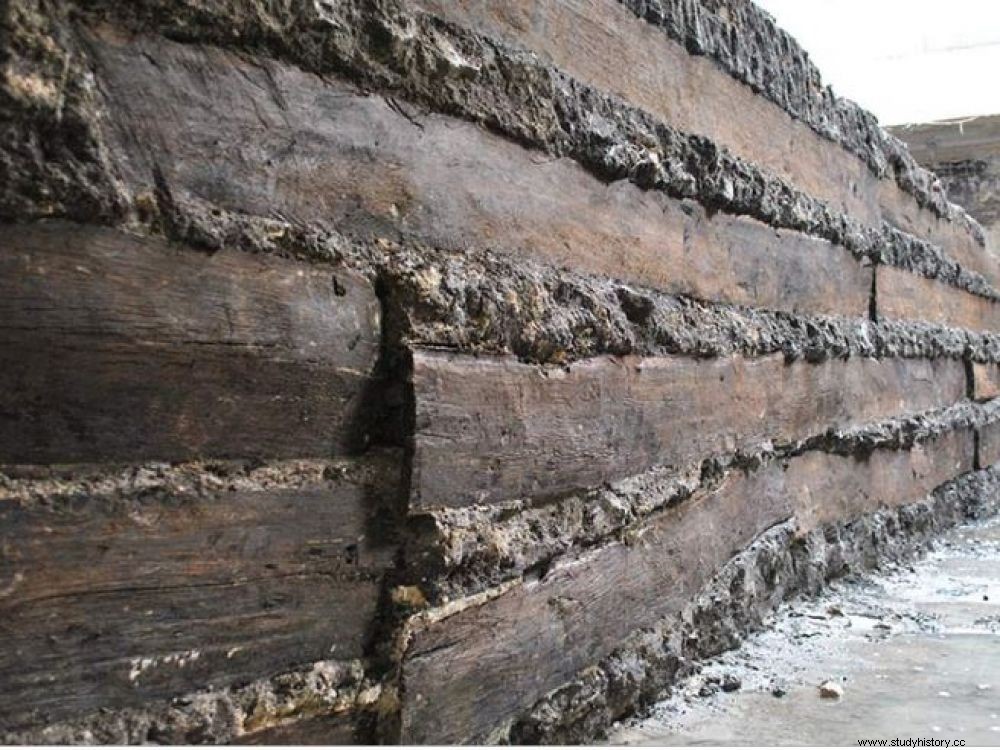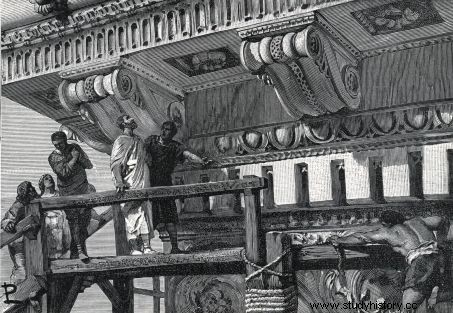The analysis of ancient wood found in Rome illustrates the powerful logistical organization and long-distance trade of this raw material in the Roman Empire.

Planks of wood used 2,000 years ago in the construction of an ancient portico, found in Rome. Traces of axes and adzes are still visible there.
"Rome was not built in a day", says the proverb. And to build the imperial monuments that contributed to the influence of the ancient city, the Romans had to resort to importing huge quantities of construction timber, a market whose trade routes researchers are beginning to trace. It is the analysis of 24 waterlogged wooden planks found extraordinarily preserved during the digging of the metro in the Italian capital (2014-2016), which has just provided decisive elements published in the journal Plos One .
Trees native to eastern France
The dendrochronological study (method consisting in counting the growth rings of the wood to obtain a dating to the nearest year) made it possible to date 8 of the 13 samples of these boards used in the construction of a portico, the oaks (Quercus sp.) having been slaughtered between the 1940s and 1960s! The researchers also succeeded for the first time in establishing their provenance. By comparing their results to the reference chronologies of Mediterranean and Central European oaks, they deduced that the trees originated from eastern France, "more precisely from the northeast of the current Jura, Alsace (upper Rhine valley), Lorraine, Champagne and Burgundy" . That is more than 1,700 kilometers from the heart of Italy.

Illustration of the use of timber in the Roman Empire. © AFP
"Rome was not built in a day", says the proverb. And to build the imperial monuments that contributed to the influence of the ancient city, the Romans had to resort to importing huge quantities of construction timber, a market whose trade routes researchers are beginning to trace. It is the analysis of 24 waterlogged wooden planks found extraordinarily preserved during the digging of the metro in the Italian capital (2014-2016), which has just provided decisive elements published in the journal Plos One .
Trees native to eastern France
The dendrochronological study (method consisting in counting the growth rings of the wood to obtain a dating to the nearest year) made it possible to date 8 of the 13 samples of these boards used in the construction of a portico, the oaks (Quercus sp.) having been slaughtered between the 1940s and 1960s! The researchers also succeeded for the first time in establishing their provenance. By comparing their results to the reference chronologies of Mediterranean and Central European oaks, they deduced that the trees originated from eastern France, "more precisely from the northeast of the current Jura, Alsace (upper Rhine valley), Lorraine, Champagne and Burgundy" . That is more than 1,700 kilometers from the heart of Italy.

Illustration of the use of timber in the Roman Empire. © AFP
The boards were transported to the Eternal City by waterways
According to Mauro Bernabei, of the Italian National Research Council (the equivalent of the French CNRS) and main signatory of the article, such a distant supply is explained by the scarcity of the resource and the specificity sought. Indeed, the wooded areas surrounding Rome and the Apennines region were quickly depleted, such was the high demand. "Different types of trees from various places around the Roman Empire and beyond were used for things like building construction, shipbuilding, or firewood" , explains the expert.

Map of the wood route and the provinces crossed for their shipment to Rome. © Mauro Bernabei et alii, PLOS ONE
At the time of Pliny (1 st century of our era), for example, the forests of North Africa had already been fully exploited. And the Romans had a clear preference for silver fir (Albies alba ) and oak, a much harder tree whose use was considered perfect for the foundations of buildings. "The distances traveled and the obstacles encountered for such a supply highlight the powerful logistical organization that the Romans had been able to put in place in areas they controlled" . From Gaul, the planks were thus transported to the Eternal City by waterway, taking the Saône and the Rhône, before crossing the Mediterranean to finally go up the Tiber to Rome.
